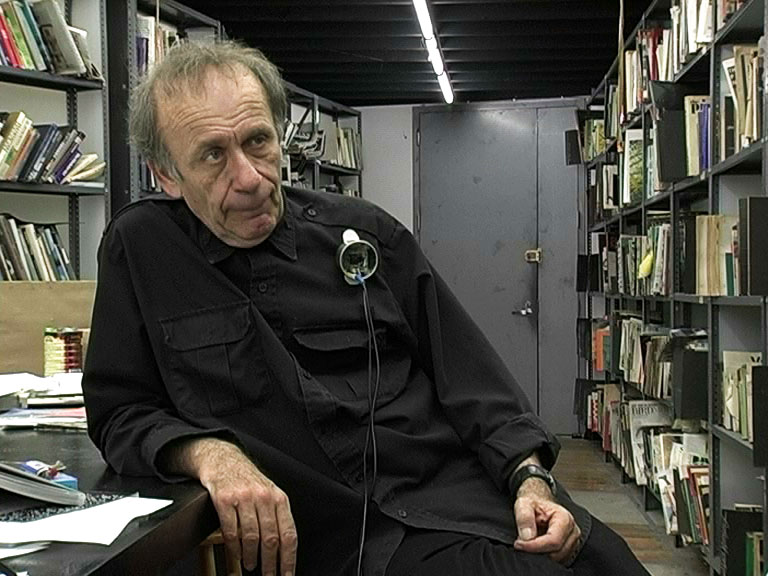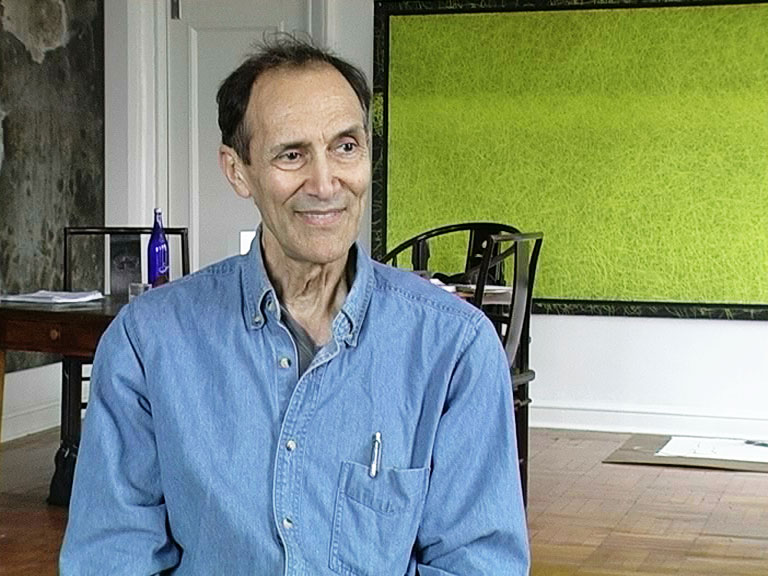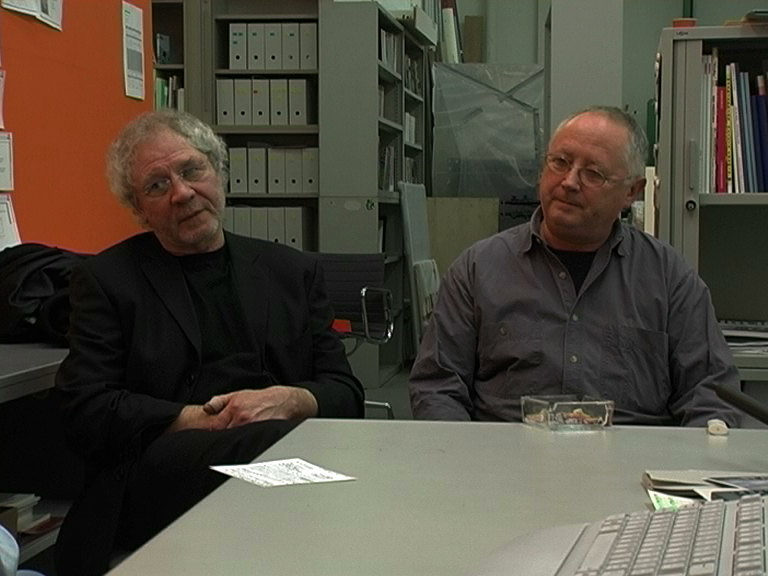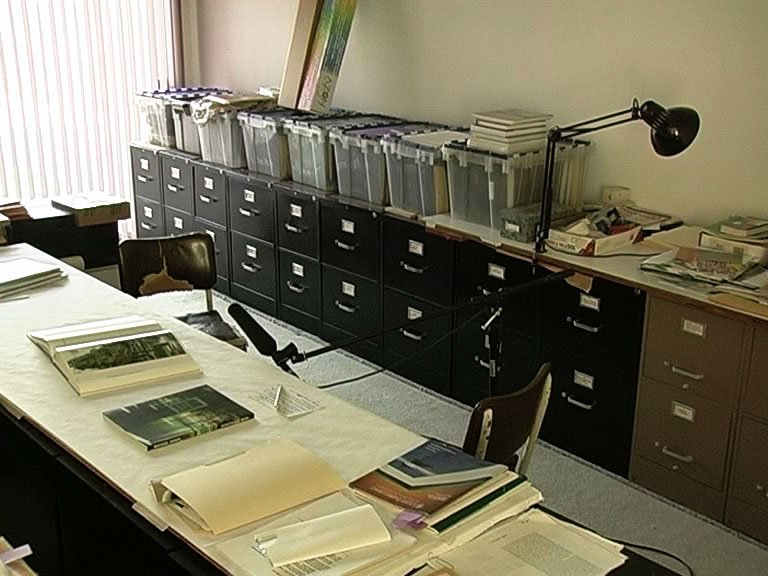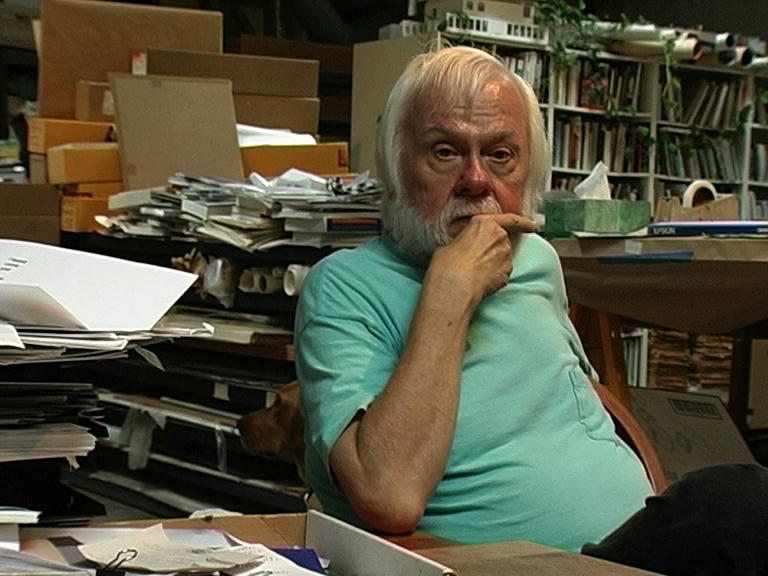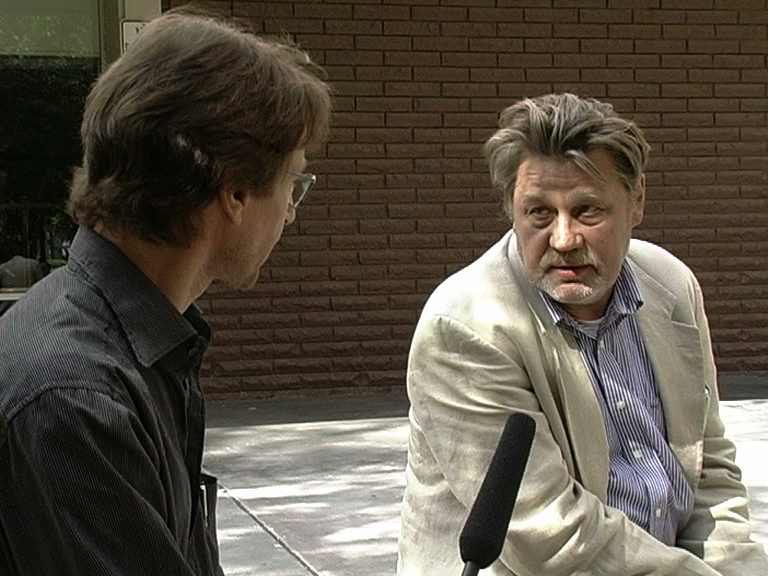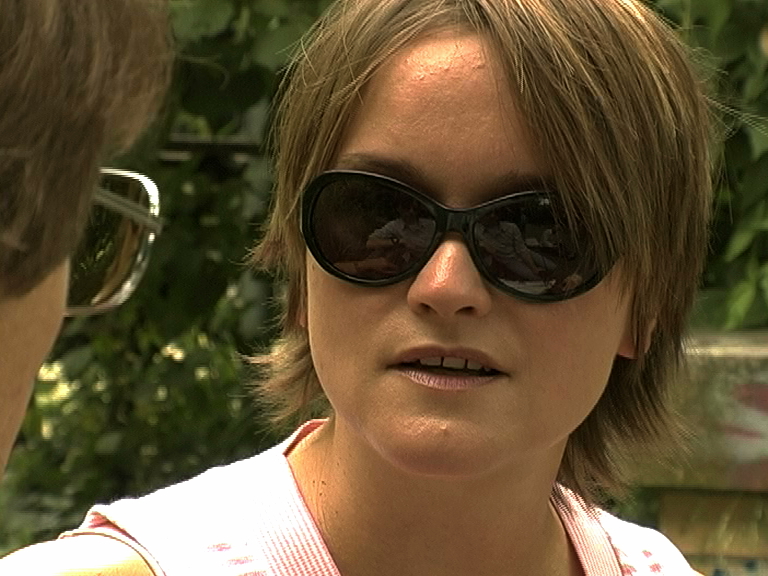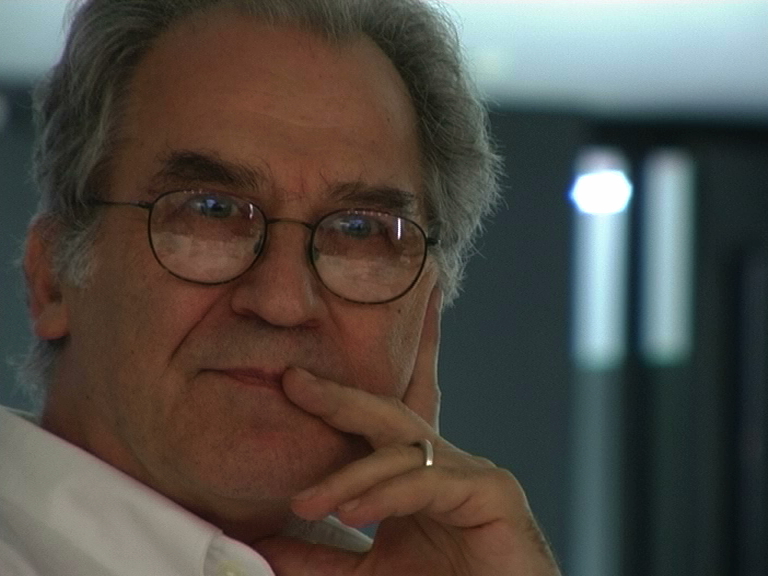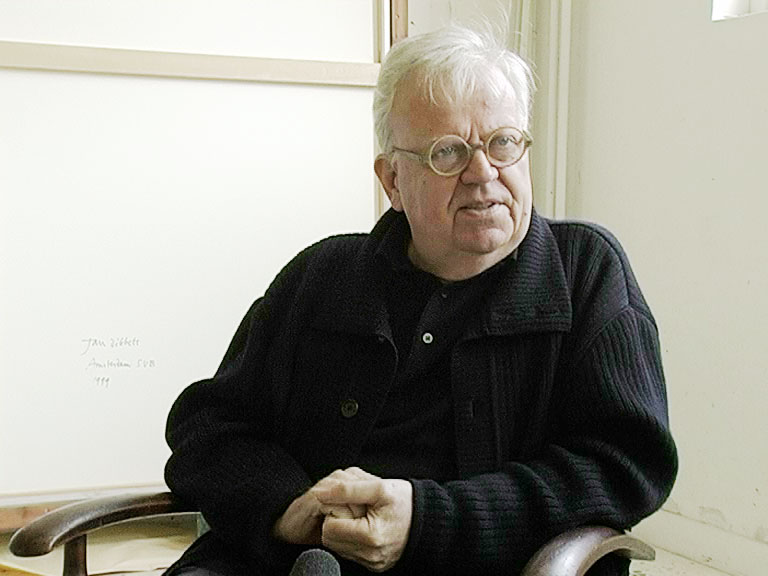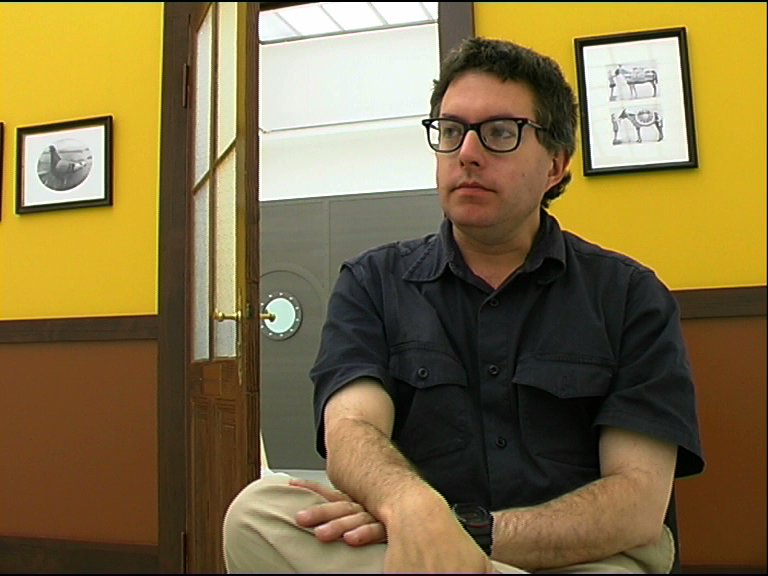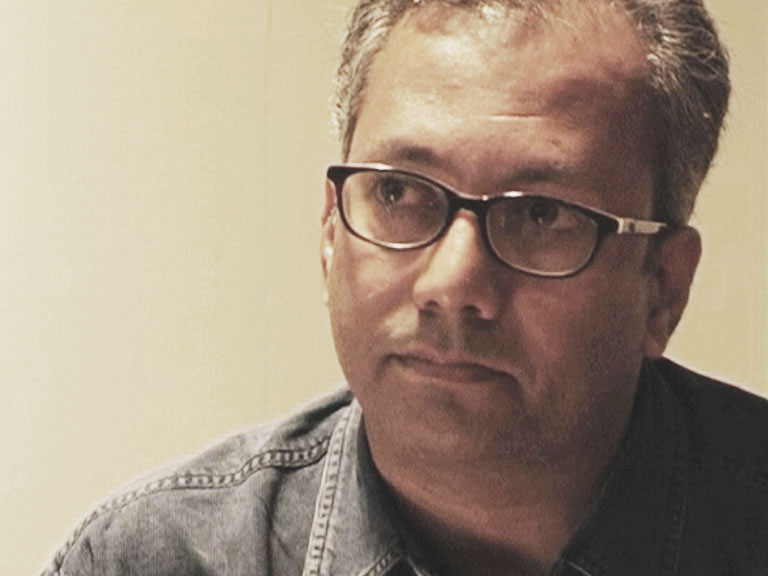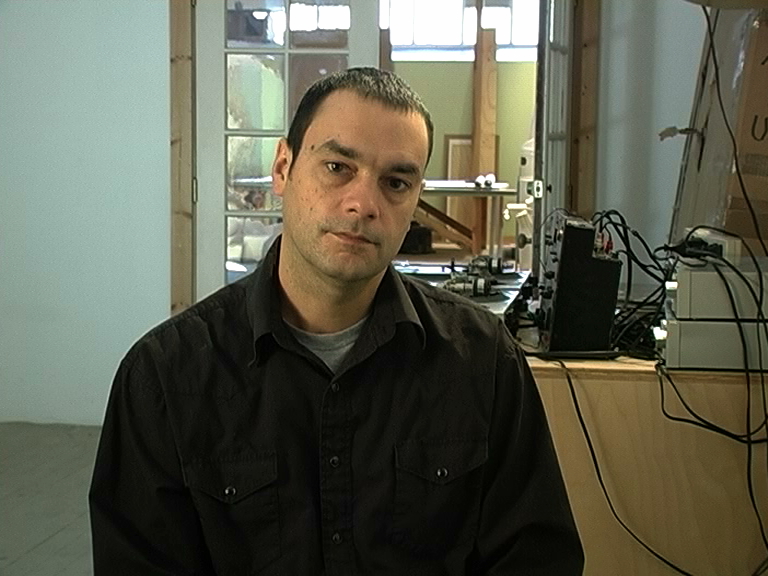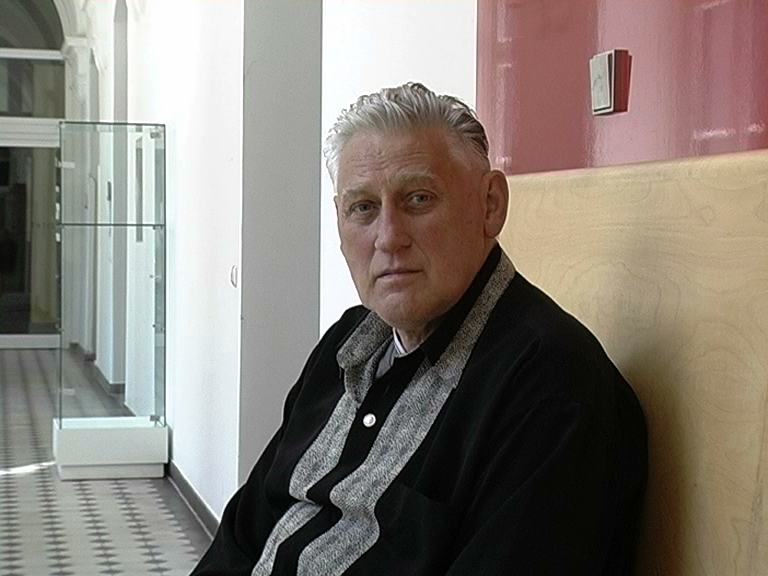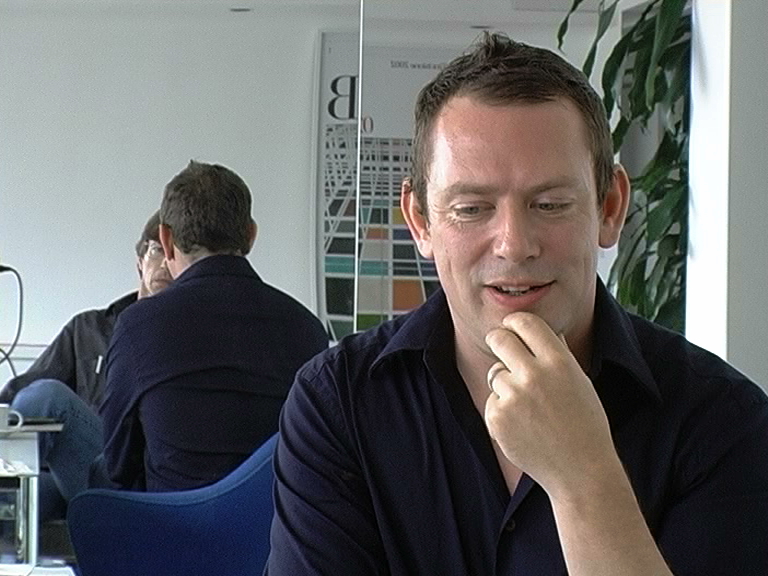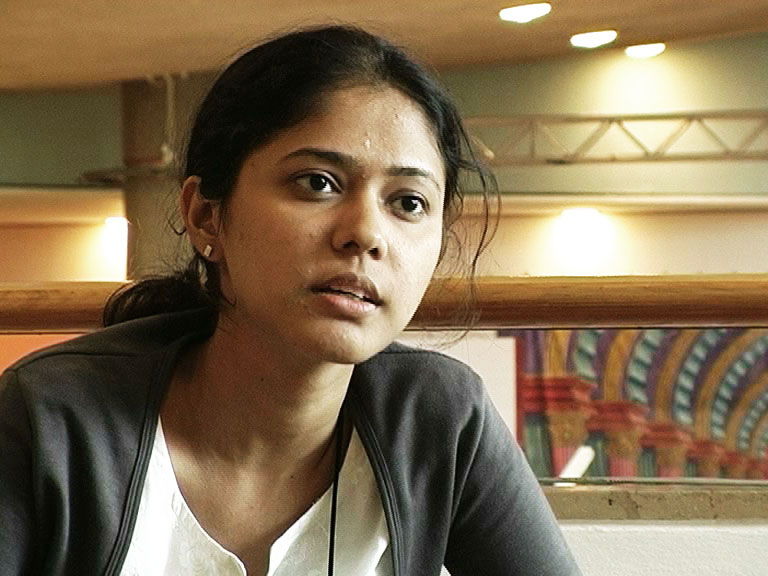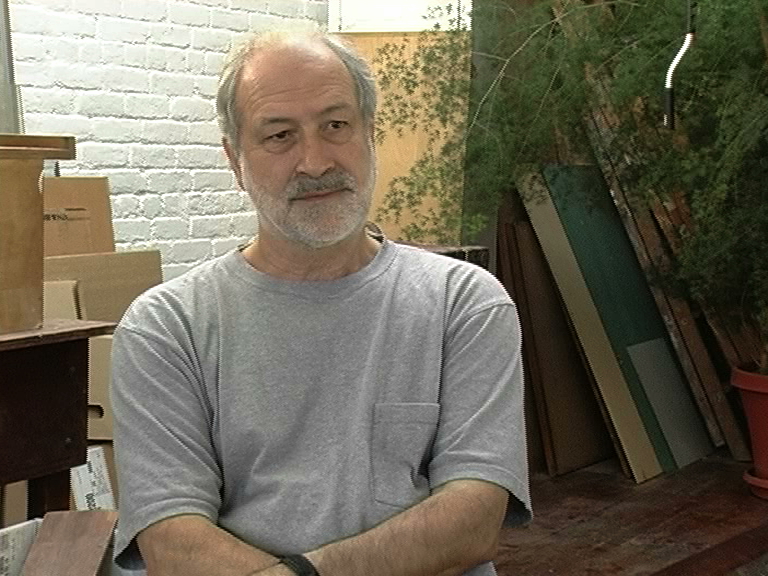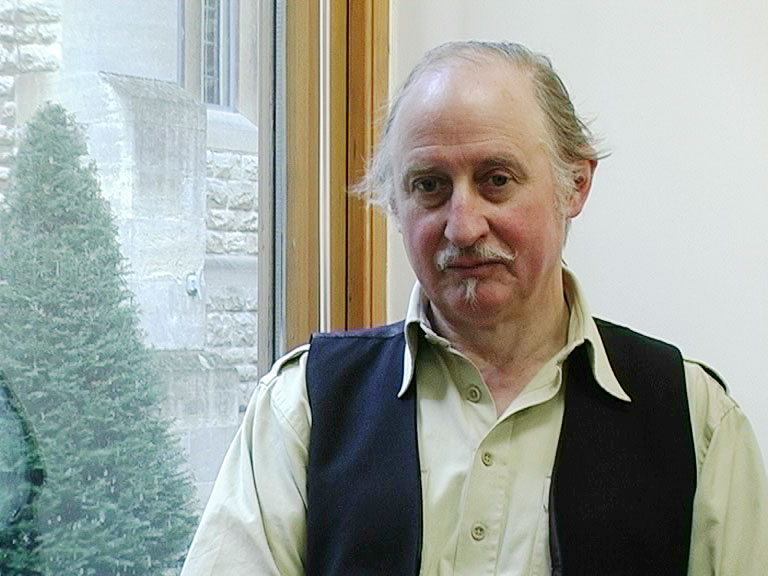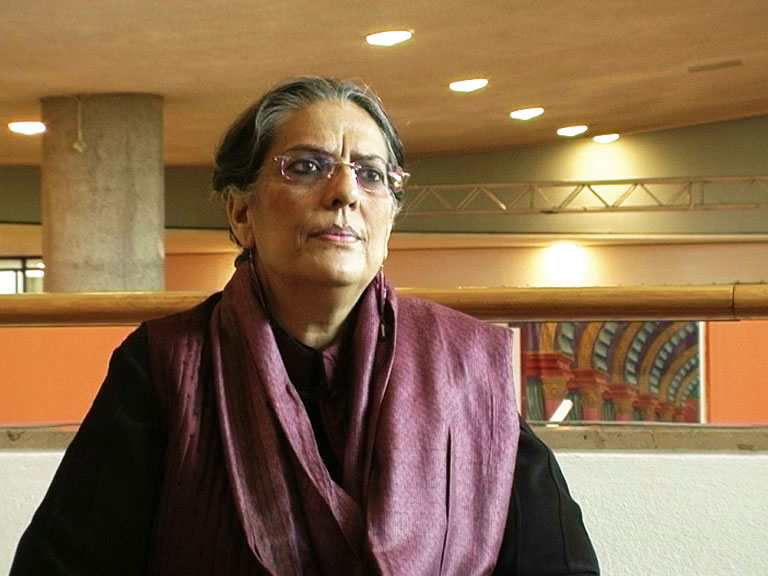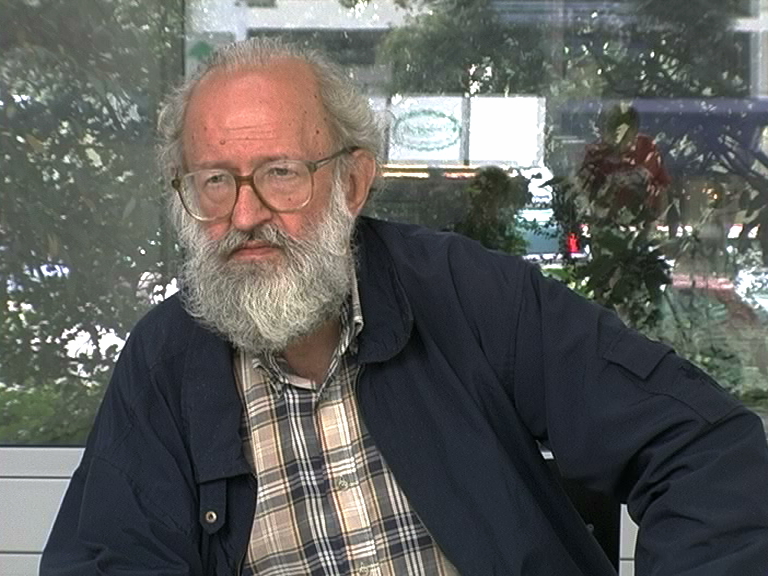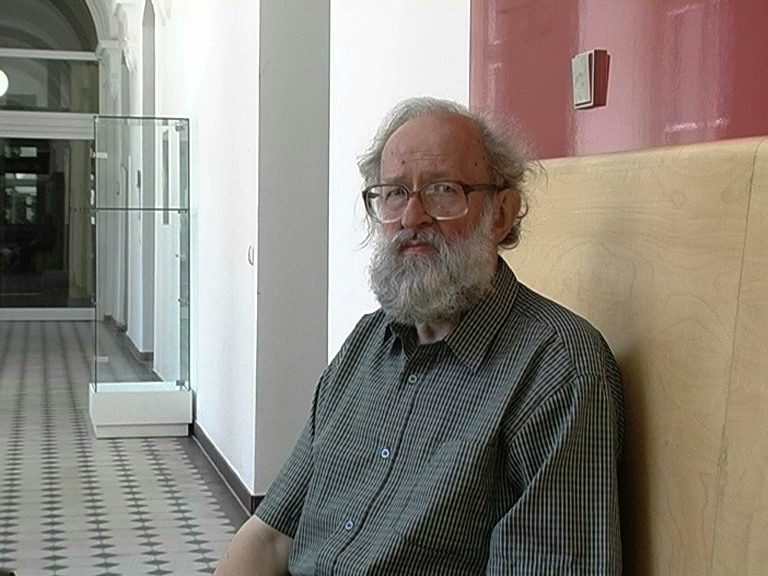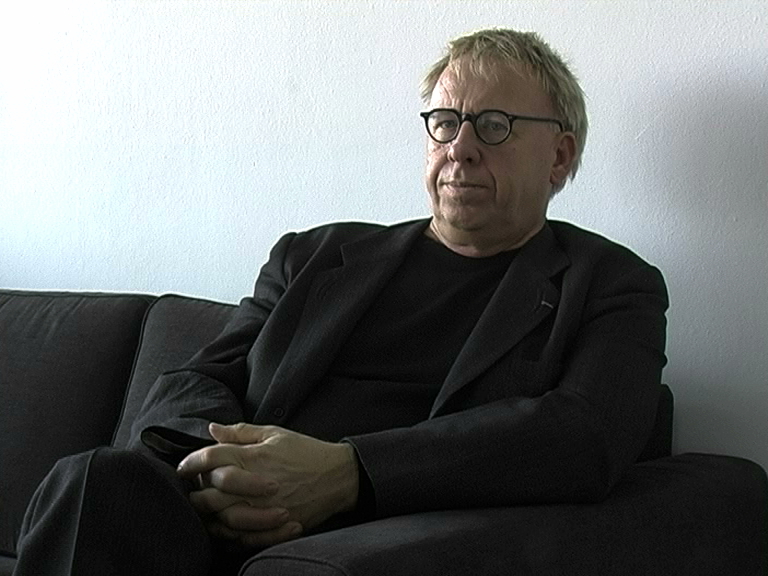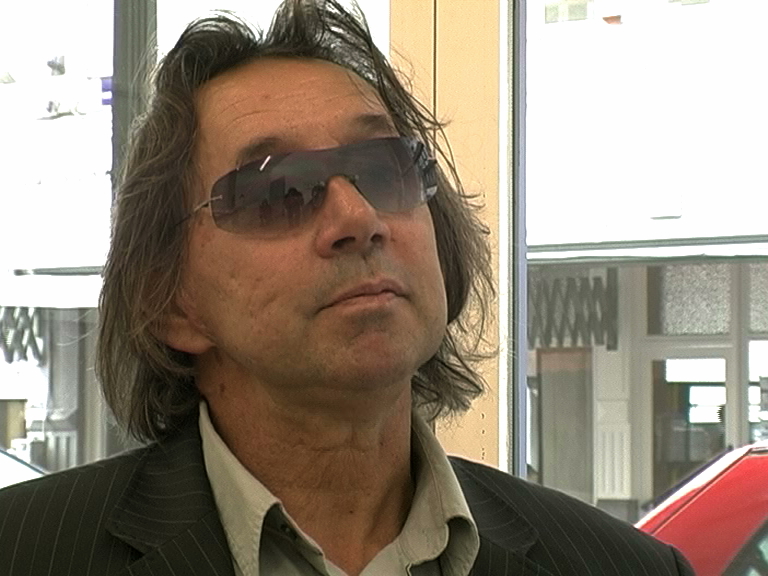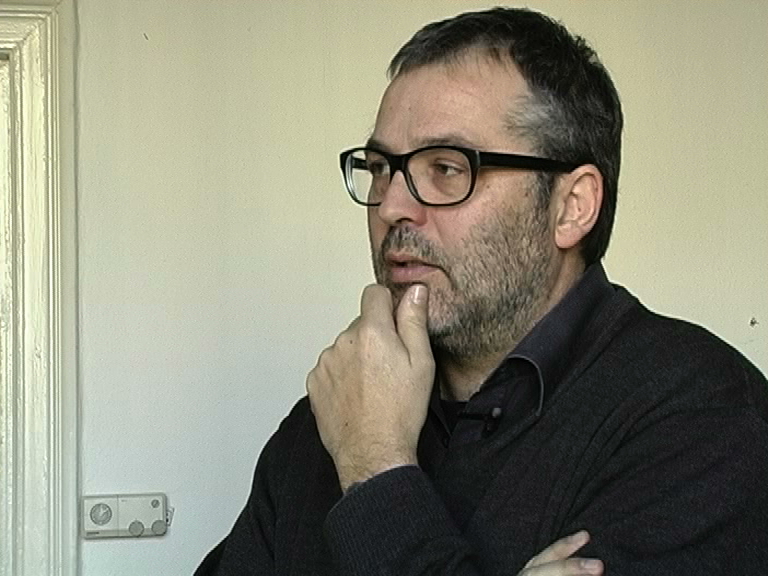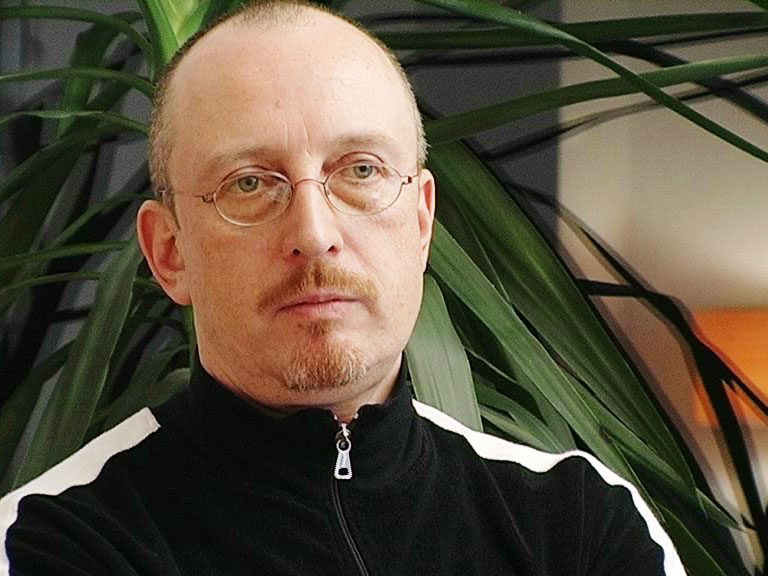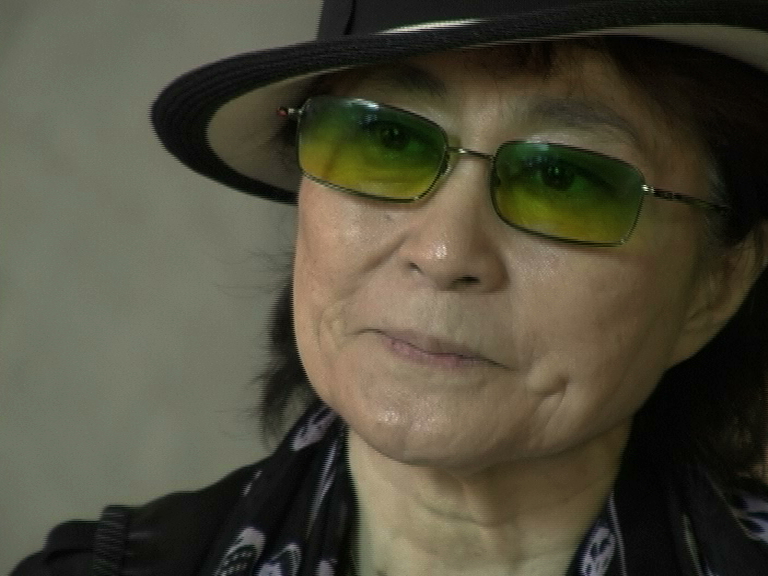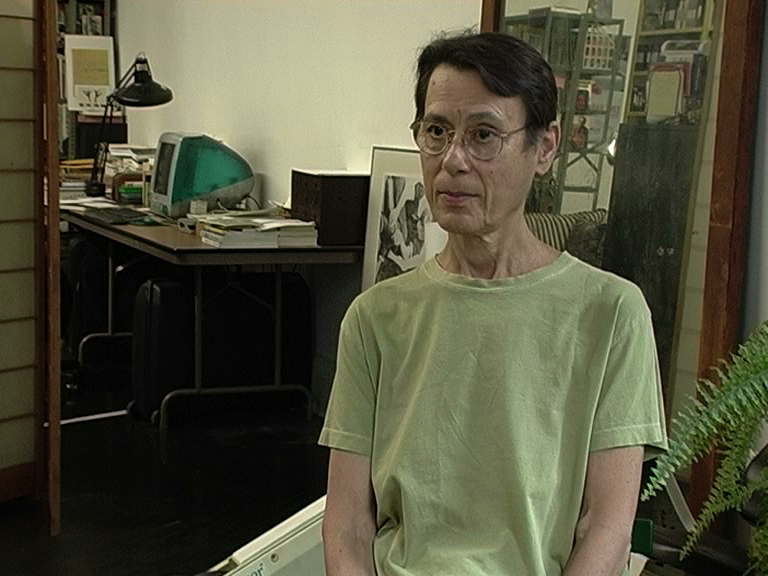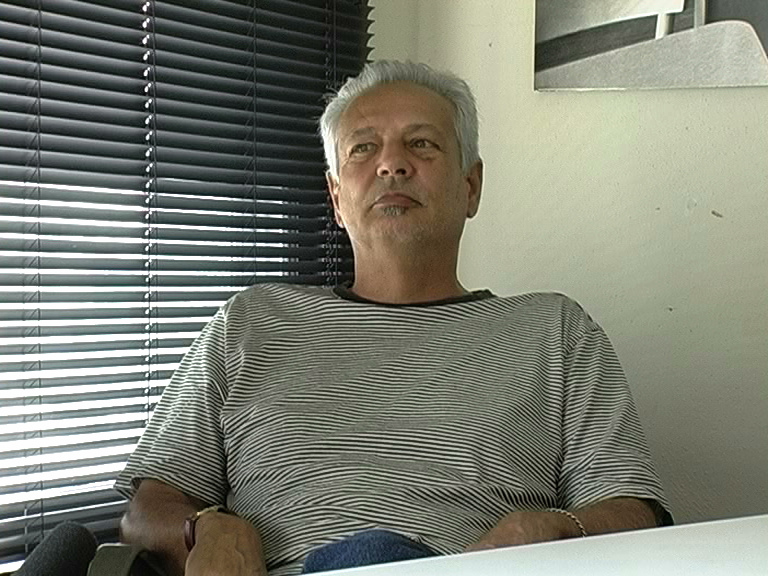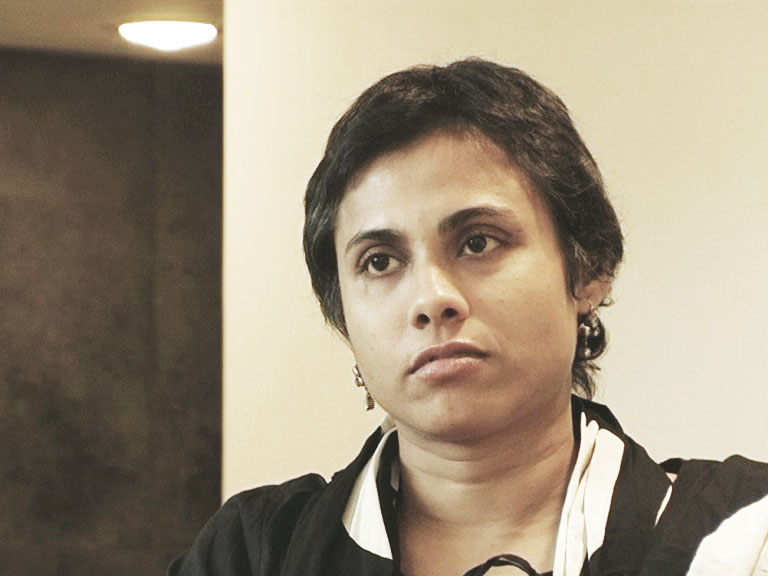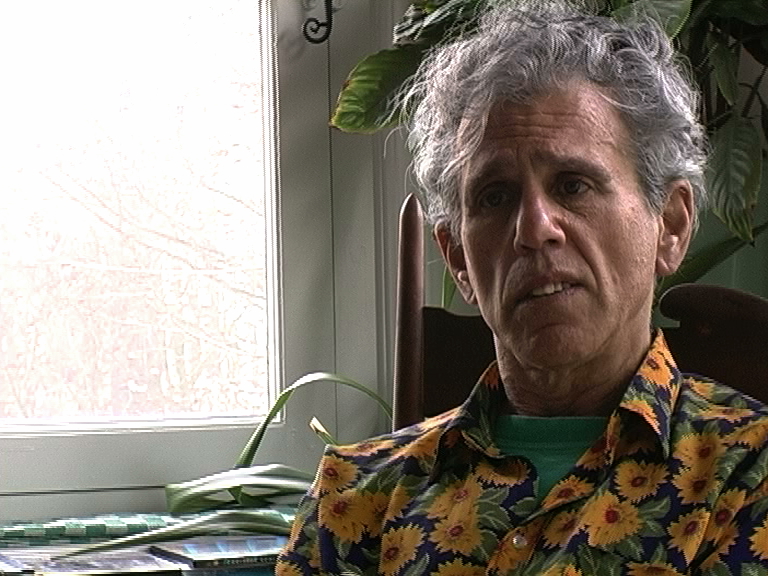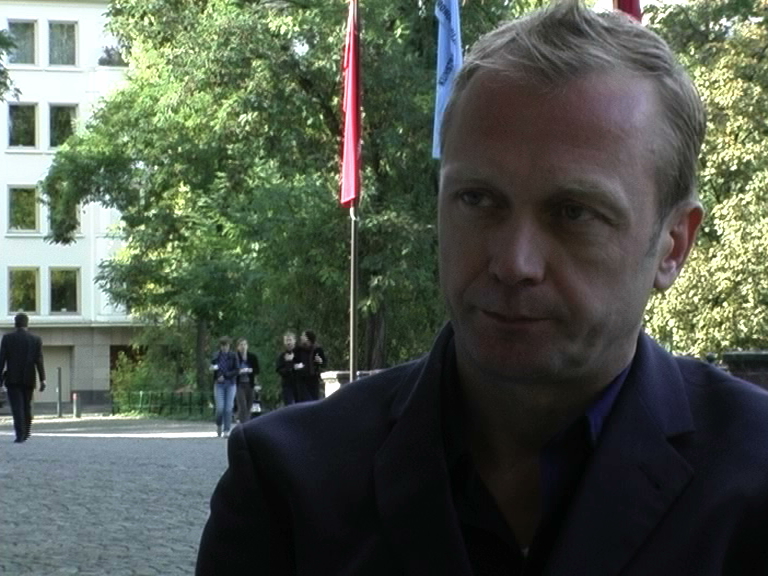S.R.: So, we are guests in the studio of Allan Sekula on the 7th of October 2004. I’m coming with the first question, and to start the whole talking I want to ask you how and when did you come to your artistic practice, which is so interestingly based on writing and photography?
A.S.: Well as a student I was painting and then I was making kind of sculpture, doing some things that might be called actions and this was in 1970/71. I started photographing to document performative works, and became increasingly interested in the evidentiary dubiousness of the photograph. And over time that became a kind of autonomous interest of the photograph. But I think that was a time when certainly semiotics and structural linguistics were very much in the air. And so the question of the relation between the photograph and its caption in new circumstances was something one could, could study, analyze, connect with the pre-existing discourse which of course emerged both in the 1930s and then again in the early 60s. And I really began to re-think the kind of institutional and sociological dimensions of the division of labour in cultural production. So, that if Conceptual art was posing the problem of the relationship between the artist and the critic, and the, you know, kind of linguistic reception conditions of works of art, the relationships of works of art to linguistic propositions. If you opened up the field to think about the everyday uses of photography, such as the press uses the photography, then you’ve had the question of the image-text-combination there and the writer-photographer-division of labour.
So in some ways it took me into questions that were very central to the problematics of visual art at that time but it also took me outside, into a broader world of media operations. So there was a kind of dynamic of inside and outside the artfield, that I think very quickly propelled me in a way and lead me to think how photojournalism worked, how the photographic picture magazine worked, how the photographic book worked in general. And I more or less learned more and more about photography through published sources being here on the westcoast there weren’t, there wasn‘t yet a highly regularized system of exhibiting photographs and collecting them in museums. If there was any place where that had been going on for some time it was in New York. And I didn’t end up in New York until 1974 after I was out of school. So I encountered the text-image-relation in published sources. And I think that had a big effect for me. Ranging from picture magazines to books on photography, books using photographs. And in the context where the question of the visual reproduction was increasingly central in thinking about art.
S.R.: For me, as I saw your big exhibition at the Generali in Vienna. For me it was the first time that I had an encounter with your early works. And it was in kind of interesting relation to each other, that I found this work that was – I forgot the title – where you make some documentation of your parents in your home. That must be very early.
A.S.: That piece I began working on in 1971 and finished in 1973. It’s not the earliest project that I take seriously as a starting point but it was certainly the most sustained project I did. I mean I set myself a time-frame with that project working on something for 2 years. And I think that was also an very important lesson. And then the idea of turning a kind of documentary eye on one’s own familial background and circumstances was somewhat unusual at that time. I mean there were… As I found it a little bit later there were a few other examples of this kind of thing in photography somewhat autobiographical works – Daniel Seymore‘s „…song“ (?). But these came from a kind of romantic, bohemian perspective rather than from a kind of cool sociological distance which was in some ways the fictional posture I adopted only to enter into a kind of crazy polemic with my parents and their world. So in some ways there were deliberate references to the social documentary photography of the 1930s but also to a kind of small cameras of the 50s which might have associated with Robert Frank. But I very much thought of it as a kind anti-family of man, this family rather than a kind of sentimentalized and generalized family, the family as a kind of ideological and socializing functions, you know, and conflicts.
S.R.: In a contrast to that I saw at the same time these works you did more or less as a student which had a very strong performative impulse. Like, I can remember this work where you’re throwing pieces of meat. I don’t know if it were steaks or something like that on the street. And another performative thing: You came with some friends to a – was it a Chinese or a Korean Imbiss? – I think it was a Chinese…
A.S.: Yea, it’s a kind of Pizza parlour. There’s a kind of joke about Maoism that runs through it.
S.R.: What I found there was, I think, this is a little bit the opposite of this approach I find in your more sociological work and your more self-reflective work. How do you see it from the perspective now?
A.S.: Well I think, it seemed like the talk even then was fairly wide open; you could pick theatrical strategies. I mean, I was very interested in Brecht. Not that I was seeing a lot of performances, but I read the plays and read theoretical writings on Theater. And I was also reading Peter Weiss and reading Gutowsky. And thinking about the living theatre you know. A whole range of theatrical projects that interested me. I also found Genet interesting, sort of reversal of power relations in a play like “the maids”. So I think that the idea that a photographic sequence could somehow come out of a theatricalized and overtly versicle kind of simple theatre appealed to me. A very simple fictionalizations. What does it mean to fictionalize a work situation when you don’t have the implements of work because they belong to the boss. You’re forced to do pantomime because you don’t own the tools. These kinds of simple problems that were part of the kind of thinking about performance, coming out of specific social problematics. And so I think that existed alongside for me a kind of a documentary investigative impulse. I mean I think the link is that in a work like “Aerospace Folktales” I’m looking at the family space as a kind of dramatic space, you know, that the lights are being adjusted. My father is keeping the house neat while he’s out of work, so he’s becoming a kind of lighting technician of everyday space. As if there were a play going on. But in fact all he’s doing, the only play is that he is writing letters, trying to apply for another job. And he’s been doing this for 2 years. So to me had a kind of a durational aspect. That somehow you could record that in a sequence of still-photographs. The relation between everyday life and theatre to me seemed fairly one of interpenetration, very much blurred boundaries. I think that’s in some ways consistent with a certain spirit of performance or even happenings at the time. I didn’t find myself that drawn to the models of performance art as such. You know, I would read magazines like Avalanche and find them interesting, find the way that events were documented interesting. Great artists and activities would be documented photographically. That struck me as interesting to bring alongside, let’s say reportage-photographs from Vietnam, the styles, the similarity between the styles of these photographs perhaps.
S.R.: I would like to focus a little bit on the thing I have in mind. For me your work always was something like a fusion of three different approaches: 1. Social research; 2. is of course the so-called Documentary photograph; And 3. that’s for me the Action which brings this together. That can be called performative or it’s also specifically for a kind of documentary photography, that you see that there is a kind of action that brings the camera or the lense in the right perspective. And my idea of your work is that in most of your big works of the last 10, 20 years, I would say 20 years that these three conditions are always fused together. Do you see it in this way?
A.S.: That’s, no, that seems like a reasonable way to divide it up. I mean I think you can… Of course one question is or one issue is that after 1981 the performative gesture drops out of the image. The image itself appears increasingly like a, let’s say, documentary image. There is a kind of distance. Typically I haven’t inserted myself as an artificer into the frame in any way. There’s no gesture within the frame that consciously calls to mind my manipulation of the scene or. So the photographs have a more beguilingly traditional documentary look perhaps. But the construction is, you know, the sequencing, the bringing of a text to bear on the image. Not in a direct way but often in a very indirect way. Another kind of referentiality, kind of parallel discourse to the image tract. That then constitutes this third term you’re talking about. And then again more recently I have returned in certain works to overt theatrical gestures, whether it be actually enacting something myself or treating a social event as if it were an opera or a theatrical process, and this kind of thing.
S.R.: Also with your riding for many years ships, to follow different trading lines of the containers. Can this be seen as a kind of documentary performance, that you have to do this, not only to get these images but also to have the experience how this life on the ships are going on, and how the ships are coming to the harbours and so on. Because I was always really impressed by this long-term research.
A.S.: Yeah, at some point you have to endure a different kind of time. Lets say from the time of artist practice as it‘s currently socialized and entered into the market, you know. Artist time is, there’s the time of the studio, there’s the time of reproduction of artists who through the schooling system, there’s the time of the gallery show. And it always struck me that people who did serious non-fiction writing, had a very different tempo to their production. George Orwell or Norman Mailer in his non-fiction, fiction works. Gloria Emmerson writing about the Vietnam war. Any of the great sort of reportage writers of the 20th century. There is a kind of an immersion that goes on in the scene, in the subject of however many years it takes to know it, to live there, to understand its literary properties, its dynamics. And for me that meant for example that I would go, as I was looking at port cities, I would often go there and not meet the artists, you know. I wouldn’t be particularly interested in the art world you know. I’d meet people who worked in the port or worked on ships and I would describe myself to them as a writer and a photographer more frequently than I would say I was an artist. Because it seemed to me that the possibility of an open exchange with them required a degree of self-effacement that the term artist doesn’t re…bly(??) call to mind in laypeoples‘ imaginations. And it’s true, that’s what I‘m typically doing, I’m writing and I’m photographing I’m making notes. I wanted to say I was a writer so they would understand that if they said something to me it wasn’t simply a story told to a photographer for whom it might only serve as background, but it might possibly be something that I would end up recounting, retelling. So that there was a kind of honesty about that and.
A.S.: Well I think often I would enter into a scene perhaps in the way of a reporter doing a deep investigation would do. I wouldn’t announce myself as an artist. I would say I’m a writer and a photographer. I would let people know that I was writing as well as photographing because then they would know that if they told me something then it might get translated in some form into a text I was preparing. I also learned ways to make notes that weren’t terribly obvious to remember the way people would phrase things, and build that into what I was writing. And I also learned a way to divide photographing from listening, looking from listening and understand that one has to be absolutely centred on one or the other. In that sense it’s not like film-making, where sound and image are often coming at you together. And I’d more or less avoid whatever art world might exist in that city or in that country. And work with people in their work-situations like shipyard workers or dock workers or people working on ships. And then tehre were this issue of experiencing the time of that world, you know, the time of these slow, heavy industrial processes.
S.R. Do you think that there is – it is always a question for me – if there is a kind of beyond this pure work of the reportage. Is there a fascination for their work or for their existence for their life, for their daily life?
A.S.: No, I think it often is fascinating. It is fascinating because, in part because it’s so often discounted, it’s seen as part of an old economy, a nice-century economy. And this to me is one of the great lies of late modernity, you know. The lie that only mental labour is important, that only the new electronic, computer based industry is significant. The failure to really even recognize that we live in a world of materials that of course have to be extracted from the earth, the earth processed, shipped often in huge volumes. And, you know, a ship carrying cement is as important as an airfreight-shipment of harddrives, you know. There is no hierarchy of importance between these things and yet we’ve come to assume that the motor of the economy is only the new technical forces. So there is a kind of imbalance that it seems to me looking at the supposedly obsolete or the supposedly derelict practices adjusts. That balance is adjusted by putting attention to the thing that’s discounted. I think, you know, obsolescence is a rumour, not a truth. One has to recover the living in the things that appear to be obsolete. So that’s a partial task for me. But one also has to recognize these systems that are implicated in cybernated systems in the like. I mean you can’t talk about the contemporary world of logistics without talking about just-in-time-production, computer-catalouging, computer manifests and these sorts of things, these kind of cybernated assembly line. One has to work on what is antiquated and discounted and also on the degree to which these things were actually integrated into a more technological event system. That’s changing all the time. And I suppose that shift, I mean I think… One way to argue is that Pop art had the consumer economy in its sights, you know, it went more or less as far as the backroom of the grocery store. You could say that Warhol took us to the backroom of the grocery store where the soup cans are still in the box and the Brillo pads are still in the box. But it was very hard to make the next step. That Conceptual art in some ways shifted the terms to largely discoursive considerations, questions of language, questions of the image. And that the emphasis on the materiality of language was very important. But what got missed maybe was the referentiality to the broader materialities of the commodity world. So that when the commodities reappeared as an object of art in the 80s it was even more fetishized than it had been in Pop art, you know. It was now really in this kind of spectacular arena of, you know, the luminous object, isolated from the chain of production.
S.R.: Did you see it as a critique?
AS.: The work of the 80s? Not much. It wasn’t a very convincing one for me. I mean I was more interested in the fact that, you know, the economy could be seen as bracketed by things like mining and banking or finance capital and industrial. That all these categories, finance capital and industrial capital it still had some meaning. The artists‘ fascination with the tertian commodity sphere was a kind of lookinglass-world that related to their own relation to the market. And perhaps at best a kind of ironization of their own relation to the market.
S.R.: When I see this kind how you are bringing critique of the ideology of the society we are living in and also the economical context of the American society in relation to global concerns – when I see this, consider this in your work, there is always something like a poetical, I would call it a poetical approach. Maybe specifically in last works, in the last two or three works – I forgot the title of the work you did in France. What was the title, you were working, you were showing this in a gallery in the south of Paris.
A.S.: “Titanic’s wake”. In Tours… Oh, no no no I also did “Dead letter office”, the work from Mexico. That was an earlier project.
S.R.: There I found some aspects, like you call it a kind of romantic impulses, something like that. Do you think that it‘s something new in your work or you‘ll found it in your whole work, like in the beginning of the 80s? Was it a decision to write a little bit more in a personal perspective. Or am I wrong that you think that you have it already in works of the 80s?
A.S.: I think I was still writing in a kind of… Well, I think there are works in the 70s where this voice is there. But what’s very interesting is that I find it now in the most unusual places. One of the most interesting things about doing the exhibition for Generali in 2003 was that when I went back for example to the very early audio-work from 1970 when I was interviewing people or just recording them clandestinely in museums. For example at the first Warhol retrospective at the old Pasadena Museum of Art in 1970. And recording their comments as a kind of record of reception of works of art which of course in an audio piece we don’t see, you only hear what people say. What I found was that those kind of comments of museum visitors had a kind of poetic logic. That I’m, that fascinated me at the time but I wasn’t fully aware of, you know. And now that voice is something that I’d like to have to appear in works, this kinds of, you know the tenor and rhythms of everyday speech, of a kind of common language or shared language. And I think the other thing is that I was increasingly interested in breaking down the barrier between the critical essay and the work of art, so that the whole research project could be neither one nor the other but some kind of new synthesis of the possibilities of both, you know. The sustained essay, kind of one meditating on a problem, trying to think about it, think of examples, develop an argument, continue the question. And then the work of the reporter-photographer and the reporter-writer loafing in with this kind of meditative and critical project in such a way that increasing the strands are there are slight shifts of tone, ways they are framed within the work that indicate their differences. But they work as a, they have a kind of unity. So part of it was trying to bring criticism and art-making together. And I think in a very different way than the more strict and disciplined types of Conceptual art sought to do that, you know. To really say, ok, it is a kind of essayistic endeavour. But where the essay is defined as a kind of play with language and with languages as a, all the polyphonic possibilities of language. I think the language does change after the 80s. And what I think about an essay is, is somewhat different by ‘83 or ‘84. Certainly the style of my critical writing when I – if I can isolate something that I would call critical writing from the last 5 years and compare that to what I was doing in the 70s – I would say that the style of the more recent things is more interesting to me. And the style of the photographs has changed, too. From these early works like “Aerospace Folktales“, in a kind of a very grubby black-and-white (…?) mode.
S.R.: Especially this work reminded me a little bit to the aesthetics of the Nouvelle Vague. As I saw it the first time I was impressed and that I thought: This is a kind of a photographic work that fits, for me, fits in the aesthetics of Nouvelle Vague.
A.S.: Well, I think that the whole, if you take, one thing that appealed to me about the maritime subject matter you have this enormous archive of fund of images one has to thinks about. Whether it’s Breughel‘s early sea-battle paintings or the whole Dutch 17th century enterprise of sea-painting or Turner or Manets paintings, sea paintings. All the films that have been made about the sea. You have the beginning of Mondrian’s career in those wave-pictures from Holland that lead to abstraction, perhaps. In some ways the challenge of historicity of the picture becomes all the more present if you pick a theme like this. What’s dead, what’s living what can be done. And also how do you rescue it from the enormous pressure of the cliché. Because this sea seems like the most clichéed subject matter you could possibly come to. It’s both bankrupt, it’s bankrupt, it‘s obsolete, it’s clichéed, it’s sentimentalized, it’s kind of empty romanticism. All these things become challenges for re-investigation.
S.R.: What I like very much in this approach, in your approach. I also see this perspective of Walter Benjamin, how he was figuring out the romantic ideal (break) For me, this mixture of, like I said, the ideal of the romantic work in Walter Benjamin’s sense, that you start with a kind of art critique impulse and you develop it into another form, in another discourse. I always saw this influence in your work. And another influence is the relevance of some post-structuralist theoretics like Michel Foucault or Roland Barthes. Sometimes you don’t take direct references to them. But I see an influence in the thinking, or in the rhetoric you are using. Is it right? Can you see this perspective that I relate Walter Benjamin to your writing or you would prefer to refuse it?
A.S.: No, no I wouldn’t refuse it at all. Reading Benjamin was extremely important for me early on, and Barthes as well. You know I was struggling to read Barthes its early “essays communication” in French. What, you know, the only French I had was what I studied at the Junior Highschool. But something must have stuck. So
you know I sort of set out to read these things before I learned that they had been translated in a British journal. At least some of them had. And probably it was a good exercise. But so… Especially as a critic I was formed through reading Levi-Strauss and Barthes and Benjamin and… But also people who were part of the continuity of the Frankfurt school in America like C. Wright Mills and there were a number of sociologists that were important, reading Max Weber, also reading Marx very crucially. I mean Foucault for example makes a point in one of his interviews saying, you know, “Marx is there but I never need to refer to him.” But I would say, I’m perfectly happy to refer both to Foucault and to reading Marx before Foucault. And particularly the sociological Marx, the Marx of the 18th Brumaire where he’s analyzing closely the coup d’etat and the dynamics of ideological conscription of the peasantry. So when I saw a film like “Les carabiniers” (J.-L. Godard) I thought, ah ok, I can connect that with the 18th Brumaire. You know, when Marx says that the empire is the small hold of the peasant unfolded in the imagination. I understand completely what Godard is doing in 1963 with that kind of strange anachronistic reference. And for me that film became much more a source than Pop art. The profundity of Godard’s understanding and kind of crazy mixing of the old regime and the kind of, the farce of Napoleon III., a kind of fictional Europe, a kind of enfolding of the newsreels of the 2nd world war with the commodity culture, of the Americanization of France in the 50s and early 60s. All of those anachronistic, or asynchronic overlays made something very rich as a model for a kind of investigation, let’s say. A kind of a poetic play with power and politics and the ideological. And so, it wasn’t, that was as important theoretically for me as any theoretical text could be. But partly because I could see it as an artist as the work of an artist, too, who could make use of theory. You know a critic could become a film-maker and do this. And so very often I was linking things through these strange circuits, you know. There was, in the case of Foucault there were certain texts of Foucault that I found more interesting than others. Because I started very early on in my interest in the history of photography to look at police photographs. I of course devoured the “Discipline and Punish”-book. Not the first books of Foucault, the madness book was the first. But, one that I first took on in a really serious way. But that also had a odd sort of early contribution to “Fish-story” because I was also reading people like Harry Braverman, the critic of Taylorism, you know, and former radical machinist, you know, a working class guy, an american sort of sociologist of labour. And I was able to read Foucault in relation to Braverman and then think about the way Taylorism could be applied to the world of shipping. And how they could… So the first thoughts I had about the box, the rationalisation of the logistics chain, came out of this odd mixing of thinking about Harry Braverman and Foucault. So I think my paths through this were different from a lot of artists‘ paths and a lot of academics‘ paths, partly because the kind of Marxist sociological tradition was more alive for me. I mean people did… A lot of people used to read sociology at the time of the Vietnam War and there were a lot of interesting sociological works then… (break)
About Foucault and Benjamin and Barthes and.
S.R.: But you ended up at, you wanted to say something about…
A.S.: I was talking about late “Les carabiniers” but.
So in some ways I think that, I mean, I more recently I’ve been impressed by the kind of argument that Michel Serres makes about the work of art also being a philosophical project. And so you can draw lessons from what we call theory. But you can also draw lessons from other literary sources or cultural sources. I mean a painting can be as profound a philosophical statement as a work of overt philosophical argumentation. And so I think I’ve become perhaps shamefully eclectic in recent years but that’s also opened things up, you know. But I think, I guess the thing I find distressing is a kind of institutionalization of a certain fairly narrow range of critical references which I think the artworld has. Often, often does. It’s not that one shouldn’t read those people but at some point reading is a, it’s a very crazy enterprise, you know. You never know what you might need to read in order to do something. If you do documentary work, one problem is that you need to read around that theme, topic, motif, read all the fiction that’s been produced around that topic or as much of it as you can to, you know. Get a hand on how it’s been imagined in different cultural periods, from different perspectives. And then there is whatever found you carry with you of philosophical sources, you know, artistic references and there are no., I think there are no formulas in a way, for any of this. But I also think it’s probably more, one has to fight the general eclecticism of the scene at the moment, you know, the kind of incoherence of, and fragmentation of it. I mean there are no. If one was emerging as an artist in the early 70s you had a feeling that there was a kind of huge juggernaut of modernism, you know, the Greenbergian model let’s say. And even if that was something of a fiction actually, that was how it was devided and you know… It was something one could contend with, one could fight it, try to think about the paths other ways to perceive. There were very concrete struggles, you know, points of conflict. And the artworld today is, there is very little contention, there’s not really a style of real argumentation or debate, you know. It’s a style of kind of theoretical referencing, you know. So as if everything is a kind of, as if all writing has been reduced to a kind of elaboration of footnotes.
S.R.: But I feel at the same time that it’s very urgent to have a very critical discourse in the artworld about the context, about the society and about the institution. Because the institution changed so much in the last 10 years. It tend to be very corporatized, and very much more oriented on capital value than cultural value. And I think it’s very important to influence this discussion.
A.S.: Absolutely, although I’m not sure how much the institution is the primary target, I mean the art institution is the primary target.
Again, the Americans have been in the lead of this kind of direct corporate sponsorship of exhibitions, also because you have the American collectors tend to be the most powerful in the world, the model of the private board of trustees and the, you know, the big donor-gift from the private collector. All of this so thoroughly structures what American museums think they can do. And I think it’s important to remember that the, you know, the United States is the most… I mean to remember the broader picture, which is that the United States is the most conservative, even reactionary developed nation in the world. The Americans elites, even elites that patronize the arts have accepted a kind of a very meagre version of the liberal social contract. So you could say that the artworld is culturally liberal but, at least in its American version, dependent on the most reactionary economics, you know. The economics, that favor in which tax policy favours the rich and a discretionary income of the rich. The artworld wouldn’t exist without this. Those European countries that continue to see the support of the arts as part of a public expense and public cost now seem increasingly somehow behind the times and not willing to accept the market logic of arts. There’s been a marketization of the idea of what culture is, what it can be. And so that even the supposedly non-commercial culture of the avantgarde – experimental work of one kind or another – is subject to market constraints in an ever more draconian way. That I think we have to struggle against but that’s a struggle about the larger economy, it‘s not the struggle of the art institution. If a trade union can sponsor an exhibition in an American museum which has happened once in my case, that’s a step forward, because at least it‘s a counterforce to the corporation.
S.R.: Do you think – when I relay to that – how do you see the politics of collecting Conceptual art. Many American artists say that the collecting of Conceptual art is much more concentrated in Europe. And they often relate it to a different kind of understanding art in society and so on. Do you agree with this?
A.S.: Yes, that‘s true. I mean I think you can find a much more sustained history of these practice. I mean if you define Conceptual art broadly, if you include, let‘s say, Fluxus and so on, certainly the European collections are much more thorough, complete. I mean you have cases, you have people like the Vogels in the United States play a very important role in supporting conceptual artists, cataloguing, building a collection, this are quite unusual collectors. But I think the major institutions have tended to shy away and do things on the impartial ways it’s the sense of (?) So the history of, I think, some of the most adventurous American art of the post-60s period has necessarily required collectors in Belgium, collectors in other European countries.
S.R.: Do you think that it’s different to work as an artist reflecting the institution of art in relation to society for example in the United States or in Europe. Is it easier in Europe to have an influence, a political influence through the institution of art? Or do you think it’s not relevant?
A.S.: Well, I think the cultural polarities are more sharply defined in the US. I mean it’s not an accident that the German artist, Hans Haacke, would develop a critique of corporate sponsorship of art in the US. Where this has been done most emphatically by companies like Mobil in the, starting in the late 70s. I mean, the American context provides the sharper models of this kind of dominance of market forces, and that’s the… The artists who call attention to that, who are up against it in a way very sharply. In Europe perhaps the cultural social safety net, even its eroding softens or shrouds somehow the necessity of critique, makes it seems perhaps less urgent. I’m not, that’s a hard one to sort out. Cause I think if we compared to film-cultures, conditions are very different.
S.R.: Concerning what you were saying about the institution and the relation to society and general politics I have another very irritating question, maybe: What do you call your aim or your goal with your practice?
A.S.: A work is a kind of invitation to a conversation, it seems to me. You put something out, you hope people see it and you hope it provokes something, some kind of a counter-narrative perhaps to the ones that dominate the scene. And I guess I’ve had a sense that documentary by opening, documentary defined intelligently can open up a broader world than the artworld, you know. That it maybe can change the audience relation to the institution. That takes some work, I mean, that takes often some collaboration with sympathetic curators or people who understand the way to shift the museum’s audiences, exhibition spaces’ audience, open up new avenues. I mean the best example for me remain the events in Seattle in 1999 where I showed “Fish story” and I was invited by the Henry Art Gallery of the university Washington. The curator there,?, wanted to show “Fish story”. It had only be shown in Europe with one showing in the US after the series of exhibitions in Europe. And she ended up talking to a professor of political science who occupied a chair funded by the westcoast long shore workers union, dockworkers‘ union, which is unusual because you don’t usually see chairs in political science or of any sort in universities, again funded by trade unions. So the idea was that I would be invited to show this work in the museum with this still sponsorship and a whole series of events would be organized around the work, asking questions about the labour history of Seattle, which is one of the more militant cities in North America. You know there was a big general strike in 1919 after the First World War and there was the 1934 west coast long shore strike. Which established the current regime of union affiliation in dock labour in the west. And I think the larger question was how did these historical moments of class struggle relate to the current crisis of the global working class in the face of corporate, multinational globalization. So the events that occurred between February and May of 1999 were a kind of laboratory for thinking: what do we do, how do we respond, how do we respond to the World Trade Organisation. As it turned out the World Trade Organisation was going to have its big meeting in Seattle that coming November. And out of some of these discussions some of the beginnings of our organization for the protest, which of course pressured a new social movement against globalization where first-world students, workers, citizens began to really try to connect with the undeveloped world and think about trade policy in a new way. So I had some small role in that, my exhibition was a kind of provocation perhaps. But I also had an analysis which I had for some time, which is that historically port workers have been in a position to think globally, you know, that the imagination of the global has not only come from elites, it’s also come from people, what theorists call subaltern positions. And that the maritime trades have been a key aspect of that. For example the abolitionist movement spread between England, Northamerica, the Caribbean and Europe and the American South partly through the circuits of seafarers, you know. Some of them were freed slaves. And that’s an important. If we understand that democracy itself is a product of the struggles of elements of the lower classes who have come to understand the possibly of freedom and the dream of universal human rights. That was the case with Thomas Payne for example, the one non-propertied theorist and activists of the American revolution, you know, he was a seafarer. So that intuition lead me to think that there can be a kind of social dialogue in which the question of democracy, the question of human rights, labour rights, global regimes of accumulation all of this can be brought to bear and discussed. And it’s not that I think the work is instrumental or I think that the work I make is a kind of tool. But I think that it can be part of a discourse, part of a conversation. And part of that conversation is about power and a part of the conversation is about aesthetics. Because the… If, in fact, the sea is an enormous aesthetic cliché, it‘s at least, it’s something we share and we can begin to talk about it. Even if it involves the banality of say “Baywatch”. (laughs) It’s something that‘s broadly cultural. And you can begin to say, what’s the appeal here, what is the sort of generalized eros of the sea, you know. It’s not just bikinis it’s also some idea of immersion, of origins, you know, by a deeply biological human longing, let’s say.
S.R.: Is it also strongly in the States, is it strongly related to the west coast? A specific habitus?
A.S.: Well, the west coast is imagined to be the beach of the country, and that means southern California. The odd thing is that the image of the beach then erases all other possible maritime representations. Very few people who live in LA know that it’s the third-biggest harbour complex in the world, bigger than Rotterdam in container tonnage, maybe not in oil shipping, but in container tonnage, which is the, usually the most significant measure. Because the Hollywood-image of the beach obscures these other identities, you know. So even if a movie like “Jaws” which actually takes place on the coast New England, it’s in the imagination of Southern California. Because wherever there’s a beach it must be Southern California. That‘s America. I think it’s part of American media culture which means that it’s part of world media culture. So, the French have Biarritz and the Cote d’Azur and Tahiti, as part of their iconography of aquatic pleasure. There’s also the American beach by around the corner and coming in very strongly too. So I never quite thought of it that way. But I think there is a kind of forcing of the image of the beach. And I grew up, I mean since I grew up in the harbour of Los Angeles from the age of eight. I was always between this idea of the beach, which was not a very good beach, bad surf and dirty water and a surf club that was mostly seen been a bunch of people who‘s took a (?) a recreational drug. And the real beach which was over on the south bay, meaning torns, Manhatten beach, Madonna beach, you know, these beaches with better surf and then this kind of adventurous coastline, that was rocky, where you could get Lobster and then the harbour. So there was a kind of mix of undomesticated, difficult rocky coastline and industrial harbour. And that’s more like what we think of as the New England coast and what we think of this, you know, Hamburg, you know one of the big industrial port space. And I think that binarism somehow structured my thinking of it. I didn’t think of it as a theme until I was in my 30s. It was kind of experienced by these two worlds. It was kind of industrial and also natural, seemimgly natural. And I think that also means, one thing I have noticed about people who grow up in maritime environments they are inclined with green politics because they’ve seen so much damage done. If you dove anywhere in the Mediterranean, the Pacific, if you spear fished in the 60s, you know, now these species are gone. You’ve seen it kind of horrendous depletion. And I think this is true through out the world. If you have a kind of democratic consciousness came out of the sea, in certain ways, so also a kind of green consciousness comes out of proximity to the sea. So to me those are critical dimensions. And I’d go further and say that we can get to a kind of elemental understanding of the origins of modernism somehow by looking at the sea. That takes a kind of detour through art history.
S.R.: You slightly drifted away from my question, but it doesn’t matter. I’ll come back to Conceptual art a little bit. Concerning what we already discussed in the earlier part of our discussion: Do you think that conceptual paradigms are still in function? Or that it’s very needful to renew them in the contemporary art production?
A.S.: Well if teaching is part of contemporary art-production, which I think it is, then I think that the lessons of Conceptualism have to be revisited, if it represents a fundamental break. Because there are real debates about whether Conceptualism represented the height of critical self-consciousness and of late-modernist practice. I’m not sure if that’s true. I mean, if you follow the argument of Jeff Wall in his now pretty famous essay for the MOKA exhibition here in Los Angeles “Reconsidering the object of art” in 1995. If I could summarize it rather crudely, what he says is that photography lacked a kind of critical self-consciousness until Conceptual art came along to stage a kind of meta-language of photo-journalism, meta-language of documentary. And to me that’s, it’s a very nice narrative because it opens up a highway. Wall goes on to say that, you know, the death of the picture, you know, the failure of Conceptual art could only lead to the return of the picture. Meaning all roads lead to Jeff Wall and his idea of the picture. Which is in some ways rather self-serving. But I think if you go back and look at the actual practice of photographers, I mean is Edward Muybridge a kind of naive realist? Hardly. Is Julia Margaret Cameron is not art? There is already a kind of theory of the image in each of these practices and it has some relation to the philosophy of its time, you know. And that’s what we need to tease out, not assume that the only significant. It’s a kind of teleology that I find just overly simplifying of the complexity and diversity of practices that existed. So for me there’s a battle to position Conceptual art within the history of modernism. But there’s also the need to open up a more complex history of photography, of any medium that recognizes that there is thought going on all the time, and conceptual struggles, if you want. There’s one problem with Conceptual art, that’s his name. What’s the rest of art? Non-conceptual art? In other words it’s like Duchamp’s famous “Bête comme un paintre”, this idea that painting is a kind of idiot-practice. So I think we need to open up a more multi-, a more heterogeneous lineage, an idea of multiple lineages. And when we do that I’m not sure Conceptual art will be the central nodal point, but it might be.
S.R.: Maybe we can, it’s possible to find some art critical aspects with which we can figure out something like the field of conceptual practices. But always keeping in mind that they don’t have very much in common. For example like in the end of the 60s. I mean, all this works had very less in common. Most of them are coming from different points, from different epistemological models. Maybe some of them painted before, but painting is the common practice on art schools, so most of them were painting. Even Lawrence Weiner was painting. We saw this show in New York, what was it called, “Before the End (The Last Painting Show)” at the Swiss Institute, like collected paintings of conceptual artists like Weiner, Barry etc. You can see it easily as a sampling of attitudes or affects, affects to the artworld.
A.S.: Oh, I think also, what’s happening now is that Minimalism is being offered as a kind of alternative to Conceptual art. One thing that makes the problematic of Conceptual art, however fractured we see it. I think you are right to say, it’s a multiple practice, and it’s not a unified practice, absolutely, there are multiple Conceptualisms. But now that Minimalism is being kind of brought into play you can see a kind of neo-neo-formalist evaluation. If Conceptualism is too dour, too severe, too linguistic, too refusing of pictorial beauty, then let’s revive Minimalism. And let’s turn it into design. Because that’s also what’s happening, in the current market context there’s a way that it’s being integrated into a generalized design, fashion paradigm which is harder to do with Conceptual art. Even though people wear T-Shirts with words on them, I mean it’s, you just can’t, you know.
S.R.: But what is interesting is, I also asked Barbara Kruger to join in this interview, and she totally refused. She said Conceptual art was never interesting for me or art in the American context, nobody is interested in America in Conceptual art. That was really interesting. And I said, why don‘t you just give us this statement for our film? I would really like to have it for the film. No, no. She totally refused to say anything about that. So she don’t want to get associated to Conceptual art. She’s insisting that her resources are coming from advertisement. And I said: Advertisment, in my perspective is strongly influenced by Conceptual art since the 70s. In my perspective from Europe, I don’t know how it is in America.
A.S.: Well since she was a designer you would think that she would know that. Perhaps she doesn’t want to admit to it.
S.R.: I don’t know, she totally refused to say anything about Conceptual art. For her it seems to have no relevance in the American context. And she said it‘s a totally, Conceptual art in reception and collections is a totally European phenomenon. I don’t know. And for me it there was a lineage out of different works in Conceptual art..
A.S.: But if you think of the metro-pictures artists, for example James Welling did an interview recently where he noted, I mean, in some ways he disassociated himself from his friends and said, you know, the photographers were interesting for me, Weston and Adams, and that’s the work I was really thinking about in this peroid. And so I think people are now revising histories. And that’s probably true when you look at James‘ work you can see an affiliation there.
Well, going back to your point about the fragmentation of Conceptualism. If we think of certain careers have been identified, at least peripherally, with Conceptualism like Gordon Matta-Clark. Or Acconci because performance and Conceptualism have overlapped, especially in some recent exhibitions like “In and out of action”. There is a way that the line of, the promise of Gordon Matta-Clark and the actual trajectory of Acconci have brought them to architecture. Come from and lead to architecture. So the painting, the edible drama of Conceptualism with painting of course is then displaced to yet another discipline in the case of those two. And of course in the case of Acconci there’s also the relation to poetry and a verbal practice. And there’s all the connection to the New Yorker poetry scene. The history still needs to be written I think. For my part, I don’t think of myself as a conceptual artist, though a lot of the work interested me and intrigued me. In some ways I wanted to a different attitude towards photography and towards language. But then if Conceptualism is as heterodox as you are suggesting, then why not say, I’m a conceptual artist; if there is room for all sorts of things.
S.R.: Of course for my perspective the Jeff Wall statement was very important, what he was writing in his text he was coming to that point where he was criticizing, as you put it, the theory of photography and the other way around the theory of Conceptual art. And he was kind of refusing both in critique. For me it was much more these three complexes I tried to point out in the beginning these three threads I found in your work, which fascinated me very early. That I was thinking that there’s a true combination of very important streams of the end 60s, beginning of the 70s. And that was the thing that drove me to the point that I always thought that your work is conceptual. Of course totally different to a kind of photography like Jeff Wall is using the more staged form of photography, but that can also have some reportage aspects sometimes…
I will come to the last question. Because we’re getting very long and getting really tired. This is a little bit strange question, a personal interest. Because the fusion of photography and writing is the main point in your practice: What was your ideal typical daily work as an artist?
A.S.: You mean, what would be a good day?
S.R.: Yes.
A.S.: (laughing) Well, there’s a lot of switch, I mean there’s, It’s hard to answer that. Because in fact writing is one kind of activity and making pictures is another kind of activity. And I find writing always painful. I often find making pictures pleasurable and though. There is also a certain amount of pain in it and difficulty in getting it right. They are just different registers and it’s very hard to do both well on the same day, let’s say. So it’s kind of alternating emphasis in my experience. And I find now, working with the moving image, which I didn’t earlier, because I didn’t like video at that time. But working now again with the moving image I find that that then triangulates things differently. I’ve often said of photography that it’s, you know it’s kind of bounded by a triangular field: painting, literature and film are the three apexes of the triangle. And then you have this kind of practice that’s never fixed. And if you go too far towards one, something happens to destroy the photographic. But the photographic in itself is a kind of interstitial existence. Even Clement Greenberg seems to have believed something like that when he said that the central characteristic of photography was its literary aspect. Which of course violates his definition of modernist practicees. Because if photography is defined only in relation to another practice then it’s somehow hybrid or not quite essential. But he used that as way of saying that justifying his liking for Walker Evans and dislike for Edward Weston. That Evans understood the literary dimension of photography. So I guess the problem is how do you keep the thing mobile. And then how do you keep a practice sort of open and free within those, that kind of triangulated space. Once you start actually doing moving images then the still image becomes, becomes all the more clear. I think what the special properties of the still image are. So that becomes interesting just phenomenologically. Because you one day you are writing, one day you’re shooting video, one day you’re making stills. I can’t say which is better. Then there is the teher is the kind of writing one does for a film. Which is very different from the writing one might do for an essay or for a text. Which is happening something I’m struggling with now, which just lead me to look at ideas of projected verse Charles Olsons theories of poetry, thinking about Harry Partch and the recitative voice, the singing voice these kinds of things, the problem of voice-over, voice-narrator. And how you write for that voice, how the voice speaks, how it poses, how its movement, you know, the sonorous movement of the voice runs in relation to a moving image. So it’s not getting, it doesn’t get any… The ideal day gets, just seems like when you can solve a new kind of problem. And actually that makes me think about the whole debate what a medium is. A critic like Rosalind Krauss increasingly defending the idea of the specifity of a medium. But I think that in her case that can often mean defending a practice, like so James Coleman’s. Where tehre is the projected image, the video image, sometimes sound, sometimes not. I was thinking, well then are we already talking about a kind of hybridity that goes beyond medium. But I actually think that if you work from, as soon as you start setting several different practices in play, one against the other – the written word and the image, moving image and the still image, the spoken word against the written word, the spoken word with the moving image, the still image with a kind of silence. All these sort of variables, each one has to be brought down to certain kinds of elemental clarity. You have to really understand what’s basic to that enterprise. And then the works becomes a kind of assembling of elements, from these elemental, kind of fund of elemental understandings. If you don‘t have the elemental understanding, you make a mistake. And the mistakes seem more grievous when the work is itself some sort of hybrid form. Where several media are intersecting. That seems to me like the challenge now. How does the rhythm of the spoken voice work in relation to the moving image. How does the sound that comes through the window work in relation to the proper voice. These sorts of problems, sort of film-maker problems I suppose. And I think one reason, one of the interesting things about the art world is, it sort of has a slightly tangential and probably parasitic relation to the film world. That films become interesting from time to time. But there are very few critics who have actually bridged both worlds. Some like Ed Michaelson would be an example. But if you look at the critics around October magazine, the core group, the older group, and that’s actually the exception, most of the rest of them have really ignored film and the challenge of film. Their ideas of medium specificity have developed in contexts in which the kind fusion of media that film represents has not really been taken on or considered. So I guess, the art world has tended to favour analytic practices over synthetic practices. That’s the reason why Conceptualism and Minimalism seem so important. The reducted moves seem like the truer ones, the more basic ones. It‘s part of the modernist heritage. But film has been a modernist art, but it’s entirely devoted to synthetic. It’s true, there are films that are analytic in character, I mean the whole structural filmmovement is about analysis. But nonetheless there is still the dream or the possibility of the synthetic work as a kind of the meta-cinematic promise.
S.R.: Like the rhythm in Eisenstein’s work was absolutely basic.
A.S.: Yes, absolutely.
S.R.: So I think we touched all the very important points. Thank you very much.




